A (Black) Gat in the Hand: Hammett & The Continental Op – Volume 3 (My intro)
“You’re the second guy I’ve met within hours who seems to think a gat in the hand means a world by the tail.” – Phillip Marlowe in Raymond Chandler’s The Big Sleep
(Gat — Prohibition Era term for a gun. Shortened version of Gatling Gun)
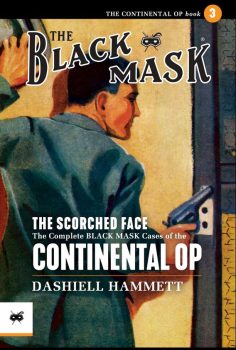 Pulp Fest took place in Pittsburgh first week of the month. It’s a really cool event, and the Hilton Doubletree is a nice site. I really enjoy it. Steeger Books rolls out its summer line at this event. And for the third year in a row, there was a new Continental Op collection, with a brand new intro by yours truly. Getting to write about Dashiell Hammett remains a definite thrill. This volume wrappd up his pre-Cap Shaw career. Here’s my new intro. Looking forward to Volume IV.
Pulp Fest took place in Pittsburgh first week of the month. It’s a really cool event, and the Hilton Doubletree is a nice site. I really enjoy it. Steeger Books rolls out its summer line at this event. And for the third year in a row, there was a new Continental Op collection, with a brand new intro by yours truly. Getting to write about Dashiell Hammett remains a definite thrill. This volume wrappd up his pre-Cap Shaw career. Here’s my new intro. Looking forward to Volume IV.
Welcome to Volume three of Steeger Books’ series on the Continental Op. Hammett had written fifteen Op stories of varying quality for Black Mask, and one rejection found its way into True Detective Mysteries (though they weren’t actually ‘true’).
He had followed hard on the heels of Caroll John Daly, whose Three-Gun Terry Mack appeared in May of 1923, and just two weeks and one issue later came the first Race Williams story, “Knights of the Open Palm.”
After one more Williams shoot-fest, Black Mask printed “Arson Plus,” and Dash Hammett began reshaping the fresh clay that was the new hardboiled school. The quality of Hammett’s work immediately surpassed that of Daly’s, though it was up-and-down. Hammett’s drinking, health issues, personal life, and problems with (his second) editor Phil Cody, made the Continental Op a bumpy ride.
Here we have the final five stories he wrote for Cody – before he quit Black Mask. Yep. Quit. Had Joseph ‘Cap’ Shaw not been committed to bringing back Hammett, we would not have had Red Harvest, or The Maltese Falcon. Hammett was willing to quit the Pulps, rather than continue to labor under Cody’s financially-unrewarding yoke.
“The Whosis Kid” had appeared in the March, 1925 issue of Black Mask. After a few lackluster efforts, it marked a return to form for the ailing author. His tuberculosis had flared up and was possibly contagious, so his wife and daughter had gone back to Montana.
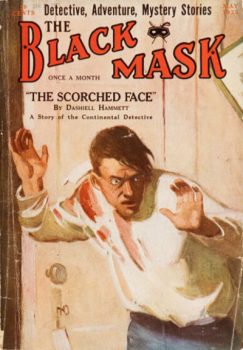 Our first story, “The Scorched Face” certainly has an intriguing title, and it was in the May, 1925 issue of Black Mask. Alfred Banbrock’s two daughters said they were going for a visit, never showed up, and seemed to have vanished. It’s not your typical missing person’s case.
Our first story, “The Scorched Face” certainly has an intriguing title, and it was in the May, 1925 issue of Black Mask. Alfred Banbrock’s two daughters said they were going for a visit, never showed up, and seemed to have vanished. It’s not your typical missing person’s case.
Race Williams stories are full of action and violence. I’ve talked in the prior introductions about the realism which Hammett included in his Op stories, drawing on his experiences working for the Pinkertons. There are elements of a ‘detective procedural’ in the stories. Here, having gathered information from the client and his wife, the Op goes back to the office. He arranges to have operatives in other branches reach out to the girls’ out-of-town friends, using a list from Mrs. Banbrock. He has the car placed on the police’s stolen vehicles list, hoping to locate it. And he also has copies of the girls’ photographs made. Then he heads out to interview some local friends. He sets the ‘agency machinery’ in motion; this is the grind of detecting.
He draws blank after blank, wearing out shoe leather, until his last visitor is so nervous, he decides to dig into her a bit the next day. Except as he reads the morning paper over his eggs, toast, grapefruit, and coffee, he discovers she killed herself that very evening. There’s something going on.
One sister is found dead in another county, and then the case peters out. The police move on to other matters, and the Op prepares to tell the client that he is giving up, when he has a sudden inspiration. He and police detective Pat Reddy compile a huge list of murdered/disappeared/committed suicide women, then dig through it. It’s dull police work, but it provides the break for a nearly dead case. Hammett manages to have the Op do boring but realistic work, without making it boring to read. That should be appreciated.
There are eleven short chapters in this novelette. Things are a bit dull for the first seven, and it really does read like a detective procedural. But it explodes in violence and mayhem in chapters eight and nine. An angry, under-clothed mob savaging the policeman, shootings, thrown objects, physical attacks from unseen assailants, jumping down staircases, chokings, pistol whippings: the sheer frenzy of violence is like a scene from Daredevil (the fantastic web series).
The explosion comes out of nowhere, and it leaves the reader breathless.
Hammett shifts gears and everything slows down. The surviving sister is found locked in a basement room behind a steel door, gun in hand, a dead body with a bullet hole, on the floor. After the prior mayhem, it’s like a stillness descending. She killed him, though with understandable reasons. The readers’ sympathy is with the girl, not the dead man. The girl is guilty, but the Op echoes Sherlock Holmes in “The Adventure of the Abbey Grange:”
“Once or twice in my career I feel that I have done more real harm by my discovery of the criminal than ever he had done by his crime. I have learned caution now, and I had rather play tricks with the law of England than with my own conscience.”
Here, the Op sees enforcing the law, and doing the right/best thing, as different. But he needs to convince his erstwhile police friend to share that view. I’ll let you see for yourself how that works out. And it wraps up with a very short O. Henry-esque ending. Henry was known for providing a twist at the end of his stories. It was nice to see Hammett use the technique in a subtle way.
I’m not gonna belabor the point, but the reader can find some elements that Hammett would use in the complex The Dain Curse. Though, smarmy cult leaders were not an uncommon trope in Pulp mysteries. And in my reading experience, they seemed more common on the West Coast.
Corkscrew” appeared four months (September) after “The Scorched Face.” which means Hammett missed a Black Mask payday – whether of his own doing, or Cody just not printing him, I don’t know. Hammett’s ill-feelings towards Cody may have left him less ‘enthused’ to crank out another Op story, quickly.
Though, only one month after the prior story, a long letter from Hammett – ‘Finger-Prints’ – ran in the July issue. A Mr. Reeves had sent a letter to Black Mask that seemed critical of Hammett’s story, “Slippery Fingers.” The author, whose stories were infused with realism, gave his detailed thoughts on Reeves’ commentary. One can envision Hammett devoting more time and energy to this pointed rebuttal, than to a new story for an editor he disliked – remuneration notwithstanding.
I said this in the intro to volume one – Zigzags of Treachery:
‘The immensely popular (Race) Williams was the prototypical gun-slinging Western cowboy who solved every problem with hot lead, but now wearing a suit and transplanted to the urban setting of city streets.’
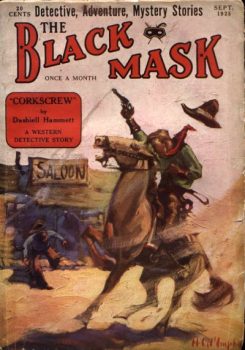 “Corkscrew” turns that on its head and takes the big city private eye into cowboy country. It reads like Hammett meets Robert E. Howard. And if you only know Howard from his Conan stories, he wrote some pretty good Westerns as well.
“Corkscrew” turns that on its head and takes the big city private eye into cowboy country. It reads like Hammett meets Robert E. Howard. And if you only know Howard from his Conan stories, he wrote some pretty good Westerns as well.
This story foreshadows the classic serialized novel, Red Harvest. The Op is hired to clean up a town. And he stirs up the local elements against each other, getting them to do much of the work for him. Here, though, the reforming crusaders provide comic relief, whereas they are his employer in Red Harvest.
The Op is appointed a deputy sheriff, which makes him the only Law in the area. With three different factions (two of which have partnered together), he is under-gunned and chooses his moments to stand firm, or to walk (or ride) away.
This is the Op functioning completely out of his element. He can’t tap agency resources or other operatives. There’s no Dick Foley, or a cooperative police detective, to help out. He does recruit a local cowboy – with the distinctive name of ‘Milk River’ – who doesn’t have very strong ties to the faction he is working for.
Clio Landes is a NYC girl who had moved out West. Like Doc Holliday, she’s a lunger: she has tuberculosis, and the local moral majority consider her a strumpet of the worst type. She does an underhanded thing to the Op, but not as a femme fatale. She is just an attractive female who used to live in the big city, but is now in the Old West. This is no Jeanne Delano.
It strikes me that Hammett wanted to do a Western, while dropping the typical trappings of an Op story. The dogged, routine detective work is missing. The Op doesn’t wear out his shoe leather interviewing people and trying to rustle up clues. Though he does get in a fair share of horse riding to go see people. And he puts his deductive skills to work regarding a rope (can’t have a Western without some cowboy rope, right?).
I really like “Corkscrew.” I don’t think I’d want the Op to be permanently assigned out West, but Hammett changes things up, and it works. And it’s a little bit of a dress rehearsal for Red Harvest: albeit in a completely different setting.
Phil Cody encouraged Hammett to ratchet up the violence and action, and he certainly did so in this story. The Op uses (other people’s) violence as a tool in his limited arsenal.
Two months after “Corkscrew,” the Op was back in familiar environs, investigating the murder of some servants in Chinatown.
Hammett knew Chinatown well, living in San Francisco, and this story basks in its aura. It feels like an entirely different city, and the Op is a stranger in a strange land. He baits a trap that nearly delivers more than he can handle. The Op’s response is the polar opposite of what Race Williams would have done.
“Dead Yellow Women” is a convoluted story, with the agency investigating the murder of a rich woman’s servant. There are shenanigans, with the Op bringing things out into the light in the final part. But the story wasn’t the strength of this one.
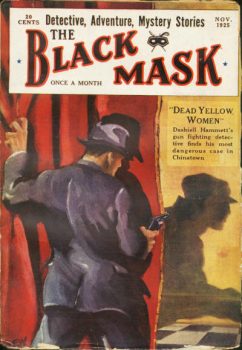 Hammett was good at providing supporting characters with depth. “The Girl with the Silver Eyes” was a prime example of that. Here, we get Dummy Uhl. Uhl had been a dummerer – a beggar who pretends they can’t speak or hear (I had to look that up). Heroin addiction made him too jumpy to continue pulling off that scam and he became an errand boy to support his habit. The Op had used him before.
Hammett was good at providing supporting characters with depth. “The Girl with the Silver Eyes” was a prime example of that. Here, we get Dummy Uhl. Uhl had been a dummerer – a beggar who pretends they can’t speak or hear (I had to look that up). Heroin addiction made him too jumpy to continue pulling off that scam and he became an errand boy to support his habit. The Op had used him before.
Hammett tells us that Uhl’s eyes didn’t show the pinpoint pupils of the heroin addict. But the Op observes that it doesn’t mean that he was off the stuff. He had put belladonna in them to distend them to normal size, and the Op wondered why. This was the kind of layering that Hammett added to his characters – and sometimes subtly developed the plot though it as well. The Op definitely uses Uhl in surprising ways in this story.
I don’t really know what to make of this one, and the Op manipulates a couple different sides. There are some arrests, some deaths, and sort of a detente with a crime boss. There’s nothing fundamentally wrong with this story, but it’s not one I go back to.
Appearing in December of 1925, “The Gutting of Couffignal” was the twentieth of twenty-one stories which Hammett wrote for Sutton or Cody. He would walk away from Black Mask after the next one. I don’t know what ‘got into him’ here, but I think it’s different from all the prior ones.
The Op is assigned to guard the presents from a wedding that had been attended by rich and politically notable people from around the world, on the island of Couffignal. Couffignal is a ‘privileged people’ community on San Pablo Bay, two hours north of San Francisco,
Hammett’s disdain of the rich comes through in the Op. ‘Most of them are well-fed gentlemen who, the profits they took from the world with both hands in their younger days now stowed away at safe percentages, have brought into the island colony so they may spend what is left of their lives nursing their livers and improving their golf game among their kind.’
He can’t wait to finish this mundane job and get off the island.
I liked the Wild West gunslinger theme of “Corkscrew.” “Gutting…” is like a Day Keene paperback, or a story from Manhunt.
The action is more something out of a Robert Ludlum or Clive Cussler novel (two of my favorites) than a typical hardboiled private eye story. A gang blows the bridge connecting the island to the mainland, kills the phone lines, sets up a car in the middle of the town square with a machine gun mounted on it, and instigates a night of terror. The lone law officer is killed when they blow up the bank.
This is a hostile takeover of an entire town, houses looted one by one. The only ‘poor people’ who live there are the shopkeepers and servants. This is essentially a paramilitary gang that is robbing an entire resort community. A Russian princess is staying on the island, with a general who leads an under-armed resistance.
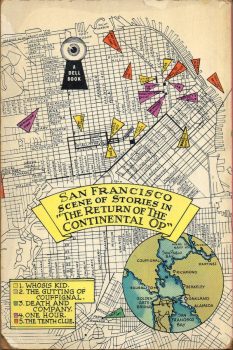 I don’t want to give away any spoilers. I think this is a fast-paced, violent, action-adventure with the Op dead-center in the middle. He takes on the role of a military commander, but also functions like a Clone Trooper. It’s safe to say that the bad guys would have succeeded if the Op hadn’t been around.
I don’t want to give away any spoilers. I think this is a fast-paced, violent, action-adventure with the Op dead-center in the middle. He takes on the role of a military commander, but also functions like a Clone Trooper. It’s safe to say that the bad guys would have succeeded if the Op hadn’t been around.
Hammett later himself criticized his denouement, saying he didn’t make the most of the situation. He said this in relation to The Maltese Falcon, and you can see some similarity to Sam Spade and Brigid O’Shaughnessy here. But his final scene does give some insight into the Op’s emotions.
To me, this is an atypical Op story, and I suspect Hammett was of the “Okay, you want action? I’ll give you plenty of action” mindset towards Cody, who he quite disliked by now. Hammett had learned in September of 1925 that his wife Josie was pregnant with their second child. The Veterans Administration had ended payments to Hammett in 1924 and Hammett threatened to quit if Cody wouldn’t pay him more. I like this story, but all things considered, it feels like a ‘Here, jackass’ piece, to Cody. Hammett would quit Black Mask after the next story.
Hammett describes a man who walks into the Continental offices, has him utter “Hell,” then pitch over dead. THAT is an opening! There’s not a whole lot more to “Creeping Siamese,” though.
It’s a slight story. The Op works in lockstep with Detective Sergeant O’Gar, who summons him on a hot lead. There are only two additional locations, and this feels like it could have been a play. No shooting, barely any on-page violence. The hot open open becomes lots of talking and the Op figuring things out as he listens. It’s not a bad story, it’s just not much of one.
There are only two parts and it wraps up rather abruptly. It almost feels like something he had written before and pulled out of a drawer and sent off to Cody for a (small) paycheck. There’s no evidence of that, and since he always needed money, it’s unlikely he had it sitting around, unused. But there’s not a lot to say about this one.
I do wanna talk about his word-smithing a little. Hammett is justifiably lauded for his lean, direct prose style. It’s the polar opposite of the over-the-top caricature style of Daly. Frederick Nebel wrote this way also. I think of it as writing well, but without too much flourish.
But sometimes, for me, Hammett flashes a similarity to Robert E. Howard. “Corkscrew” opens with the Op taking ‘an automobile stage’ from California through the Arizona desert. Hammett is quite evocative in the first few paragraphs:
‘Boiling like a coffeepot before we were five miles out of Filmer, the automobile stage carried me south into the shimmering heart and bitter white dust of the Arizona desert.’
Those first words of the story paint a picture of a city man moving into the brutal heat of the Southwestern desert. Hammett was rarely so descriptive of the environment:
‘The car crept through the soft sifting sand, wound between steep-walled red mesas, dipped into dry arroyos where clumps of dusty mesquite were like white lace in the glare, and skirted sharp-edged barrancas.’
Finally arriving in Corkscrew without ‘banging out of existence in one explosive flash’ due to the heat, he paints a picture of a town so unimpressive that calling it a village would have been flattery. This is a sad little town, baking under the desert sun. And the Op, a fat little man sweltering in a strange environment, is a fish out of water.
Hammett could just have had the Op get out of the cab in the deserted town square and comment on the heat and the shabbiness. Of course, getting paid by the word, that wouldn’t pay the bills. But instead, he showed that he could paint word pictures with the best of his fellow Pulpsters.
Hammett wanted more money, and Cody said ‘No.’ He alleged that the magazine owed him $300, and Cody denied it. We’ve already seen that Cody refused to publish Hammett more than once every two months. Dash had had enough.
So, the best hardboiled Pulp writer took a full-time job as an advertising manager for a jewelry store and quit Black Mask. The Cody Era was over. Joe ‘Cap’ Shaw would replace Cody, give Hammett the disputed $300, and build him up as ‘his guy.’ The author returned in February of 1927 with “The Big Knock-Over.” Following that with “$106,000 Blood Money,” Hammett would definitely be better than ever.
There is a false narrative that Cap Shaw made Hammett, and made Black Mask, hardboiled. As these first three volumes have shown, Hammett was fashioning the new genre (alongside Daly) under Phil Cody and George W. Sutton. The Continental Op came before Shaw.
What we’ll see in ensuing volumes is that Hammett flourished and became the all-time greatest hardboiled writer (he’s got my vote over Chandler) under Shaw. And Black Mask became the standard every other hardboiled/crime Pulp strove to match.
Hammett doesn’t write Red Harvest, and The Maltese Falcon, without Shaw as editor. But Sutton, and then Cody, were his editors as Hammett developed. You’ve read all those stories. Next up, Hammett and Shaw.
Other Steeger Books Intros I’ve Written:
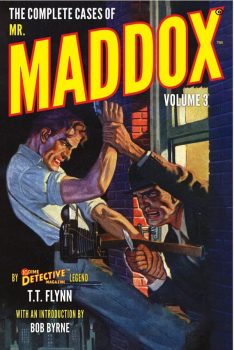 Hugh B. Cave’s Peter Kane
Hugh B. Cave’s Peter Kane
Norbert Davis in Black Mask – Volume 1
Norbert Davis’ Max Latin
Dashiell Hammett – The Continental Op: Volume I
Dashiell Hammett – The Continental Op: Volume II
John Lawrence’s Cass Blue
Paul Cain’s Fast One
T.T. Flynn’s Mr Maddox
T.T. Flynn’s Mike & Trixie (The ‘Lost Intro’)
Prior Posts in A (Black) Gat in the Hand – 2025 (9)
Shelfie – Dashiell Hammett
Windy City Pulp & Paper Fest – 2025
Will Murray on Who was N.V. Romero?
Conan – The Phoenix in the Sword in Weird Tales
More of Robert E. Howard’s Kirby O’Donnell
More Weird Menace from Robert E. Howard – Conrad and Kirowan
Hardboiled Gaming- LA Noire
Western Noir: Hell on Wheels
T.T. Flynn’s Mr Maddox
Prior Posts in A (Black) Gat in the Hand – 2024 Series (11)
Will Murray on Dashiell Hammett’s Elusive Glass Key
Ya Gotta Ask – Reprise
Rex Stout’s “The Mother of Invention”
Dime Detective, August, 1941
John D. MacDonald’s “Ring Around the Readhead”
Harboiled Manila – Raoul Whitfield’s Jo Gar
7 Upcoming A (Black) Gat in the Hand Attractions
Paul Cain’s Fast One (my intro)
Dashiell Hammett – The Girl with the Silver Eyes (my intro)
Richard Demming’s Manville Moon
More Thrilling Adventures from REH
Prior Posts in A (Black) Gat in the Hand – 2023 Series (15)
Back Down those Mean Streets in 2023
Will Murray on Hammett Didn’t Write “The Diamond Wager”
Dashiell Hammett – ZigZags of Treachery (my intro)
Ten Pulp Things I Think I Think
Evan Lewis on Cleve Adams
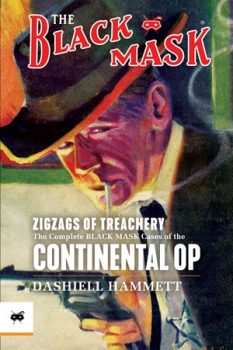 T,T, Flynn’s Mike & Trixie (The ‘Lost Intro’)
T,T, Flynn’s Mike & Trixie (The ‘Lost Intro’)
John Bullard on REH’s Rough and Ready Clowns of the West – Part I (Breckenridge Elkins)
John Bullard on REH’s Rough and Ready Clowns of the West – Part II
William Patrick Murray on Supernatural Westerns, and Crossing Genres
Erle Stanley Gardner’s ‘Getting Away With Murder (And ‘A Black (Gat)’ turns 100!)
James Reasoner on Robert E. Howard’s Trail Towns of the old West
Frank Schildiner on Solomon Kane
Paul Bishop on The Fists of Robert E. Howard
John Lawrence’s Cass Blue
Dave Hardy on REH’s El Borak
Prior posts in A (Black) Gat in the Hand – 2022 Series (16)
Asimov – Sci Fi Meets the Police Procedural
The Adventures of Christopher London
Weird Menace from Robert E. Howard
Spicy Adventures from Robert E. Howard
Thrilling Adventures from Robert E. Howard
Norbert Davis’ “The Gin Monkey”
Tracer Bullet
Shovel’s Painful Predicament
Back Porch Pulp #1
Wally Conger on ‘The Hollywood Troubleshooter Saga’
Arsenic and Old Lace
David Dodge
Glen Cook’s Garrett, PI
John Leslie’s Key West Private Eye
Back Porch Pulp #2
Norbert Davis’ Max Latin
Prior posts in A (Black) Gat in the Hand – 2021 Series (7 )
The Forgotten Black Masker – Norbert Davis
Appaloosa
A (Black) Gat in the Hand is Back!
Black Mask – March, 1932
Three Gun Terry Mack & Carroll John Daly
Bounty Hunters & Bail Bondsmen
Norbert Davis in Black Mask – Volume 1
Prior posts in A (Black) Gat in the Hand – 2020 Series (21)
Hardboiled May on TCM
Some Hardboiled streaming options
Johnny O’Clock (Dick Powell)
Hardboiled June on TCM
Bullets or Ballots (Humphrey Bogart)
Phililp Marlowe – Private Eye (Powers Boothe)
Cool and Lam
All Through the Night (Bogart)
Dick Powell as Yours Truly, Johnny Dollar
Hardboiled July on TCM
YTJD – The Emily Braddock Matter (John Lund)
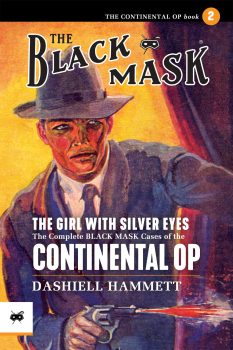 Richard Diamond – The Betty Moran Case (Dick Powell)
Richard Diamond – The Betty Moran Case (Dick Powell)
Bold Venture (Bogart & Bacall)
Hardboiled August on TCM
Norbert Davis – ‘Have one on the House’
with Steven H Silver: C.M. Kornbluth’s Pulp
Norbert Davis – ‘Don’t You Cry for Me’
Talking About Philip Marlowe
Steven H Silver Asks you to Name This Movie
Cajun Hardboiled – Dave Robicheaux
More Cool & Lam from Hard Case Crime
A (Black) Gat in the Hand – 2019 Series (15)
Back Deck Pulp Returns
A (Black) Gat in the Hand Returns
Will Murray on Doc Savage
Hugh B. Cave’s Peter Kane
Paul Bishop on Lance Spearman
A Man Called Spade
Hard Boiled Holmes
Duane Spurlock on T.T. Flynn
Andrew Salmon on Montreal Noir
Frank Schildiner on The Bad Guys of Pulp
Steve Scott on John D. MacDonald’s ‘Park Falkner’
William Patrick Murray on The Spider
John D. MacDonald & Mickey Spillane
Norbert Davis goes West(ern)
Bill Crider on The Brass Cupcake
A (Black) Gat in the Hand – 2018 Series (32)
George Harmon Coxe
Raoul Whitfield
Some Hard Boiled Anthologies
Frederick Nebel’s Donahue
Thomas Walsh
Black Mask – January, 1935
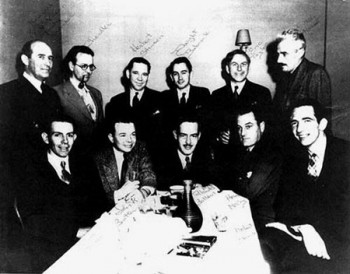 Norbert Davis’ Ben Shaley
Norbert Davis’ Ben Shaley
D.L. Champion’s Rex Sackler
Dime Detective – August, 1939
Back Deck Pulp #1
W.T. Ballard’s Bill Lennox
Erle Stanley Gardner’s The Phantom Crook (Ed Jenkins)
Day Keene
Black Mask – October, 1933
Back Deck Pulp #2
Black Mask – Spring, 2017
Erle Stanley Gardner’s ‘The Shrieking Skeleton’
Frank Schildiner’s ‘Max Allen Collins & The Hard Boiled Hero’
A (Black) Gat in the Hand: William Campbell Gault
A (Black) Gat in the Hand: More Cool & Lam From Hard Case Crime
MORE Cool & Lam!!!!
Thomas Parker’s ‘They Shoot Horses, Don’t They?’
Joe Bonadonna’s ‘Hardboiled Film Noir’ (Part One)
Joe Bonadonna’s ‘Hardboiled Film Noir’ (Part Two)
William Patrick Maynard’s ‘The Yellow Peril’
Andrew P Salmon’s ‘Frederick C. Davis’
Rory Gallagher’s ‘Continental Op’
Back Deck Pulp #3
Back Deck Pulp #4
Back Deck Pulp #5
Joe ‘Cap’ Shaw on Writing
Back Deck Pulp #6
The Black Mask Dinner

Bob Byrne’s ‘A (Black) Gat in the Hand’ made its Black Gate debut in 2018 and has returned every summer since.
His ‘The Public Life of Sherlock Holmes’ column ran every Monday morning at Black Gate from March, 2014 through March, 2017. And he irregularly posts on Rex Stout’s gargantuan detective in ‘Nero Wolfe’s Brownstone.’ He is a member of the Praed Street Irregulars, founded www.SolarPons.com (the only website dedicated to the ‘Sherlock Holmes of Praed Street’).
He organized Black Gate’s award-nominated ‘Discovering Robert E. Howard’ series, as well as the award-winning ‘Hither Came Conan’ series. Which is now part of THE Definitive guide to Conan. He also organized 2023’s ‘Talking Tolkien.’
He has contributed stories to The MX Book of New Sherlock Holmes Stories — Parts III, IV, V, VI, XXI, and XXXIII.
He has written introductions for Steeger Books, and appeared in several magazines, including Black Mask, Sherlock Holmes Mystery Magazine, The Strand Magazine, and Sherlock Magazine.
You can definitely ‘experience the Bobness’ at Jason Waltz’s ’24? in 42′ podcast.